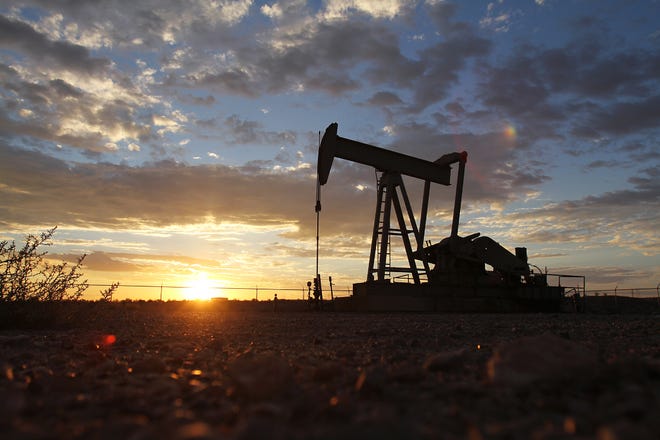Webinar provided updates on New Mexico's efforts to develop methane reduction rules

AZTEC — The New Mexico Environment Department and Energy, Minerals and the Natural Resources Department plan to release draft complimentary regulations for reducing methane emissions from the oil and gas sectors later this year.
The two departments wrapped up their information gathering phase, which included public meetings and the Methane Advisory Panel, and are now starting on phase two — developing the draft rules.
A community impacts meeting via webcast on March 19 provided opportunities for the public to learn more about the process and why the state believes these regulations are important.
More:The state is drafting new methane regulations, but some fear that will devastate an industry
These new rules come as a result of an executive order Gov. Michelle Lujan Grisham issued shortly after taking office in 2019.
The Methane Advisory Panel’s report focused largely on technology that could help reduce emissions, and also includes information about how expensive that technology would be to implement.
Oil and gas industries are vital parts of the New Mexico economy

The oil and natural gas industries play a key role in the New Mexico economy and provide a large portion of the state’s general fund.
According to Legislative Finance Committee Chief Economist Dawn Iglesias, a downturn in the energy industry in New Mexico would have a greater impact to the state’s general fund than a moderate recession.
That also makes New Mexico very susceptible to changes in the price of oil and gas.
She said a $1 change in the average annual price of oil would result in a $22 million impact to the state general fund while a 10-cent change in average annual natural gas price would result in a $17 million impact to the general fund.
Oil Conservation Division Director Adrienne Sandoval said oil production has increased 600% in New Mexico since 2011.
Increased production means more emissions, which could impact health

That increase in production comes with a cost to the environment and people living around the sites, officials say. As production increases, so do the emissions related to the oil and gas industries.
Methane emissions have been tied to venting and equipment leaks.
Sandoval said the Oil Conservation Division does have a no venting or flaring rule, but “the exceptions within the rule swallow the rule.”
NMED Air Quality Bureau Chief Elizabeth Kuehn said methane is a potent greenhouse gas, meaning emissions contribute to climate change. The emissions streams that include methane also include other pollutants, such as volatile organic compounds. These volatile organic compounds contribute to ozone formation.
Ozone in the lower atmosphere has been linked to health conditions, such as asthma and cardiovascular conditions.
Srikanth Paladugu, the bureau chief with the New Mexico Department of Health's Environmental Health Epidemiology Bureau, Epidemiology and Response Division, said there tend to be more asthma-related visits to the emergency department in the San Juan Basin on days with high ozone and particulate matter levels.
Not much is known about the impacts oil and gas development has on health in New Mexico.
The Health Effects Institute-Energy, a nonprofit group based out of Boston, has been reviewing scientific literature published in peer-reviewed journals to determine the impacts. Donna Vorhees, the director of the Energy Research Program at Health Effects Institute, said the nonprofit is funded by the government as well as the oil and gas industry, however its research is done independent of its sponsors.

She said the group identified 113 studies about the impacts of oil and gas on air quality. Very few of those studies looked at New Mexico. The studies had varying conclusions and, in many cases, Vorhees said they could not make a definitive link to oil and gas production due to the presence of other emission sources.
The nonprofit also reviewed epidemiology literature. Vorhees said studies have reported increased perinatal impacts, cancer, respiratory illness, cardiovascular disease and a range of symptoms in communities living near oil and gas production areas. However, she said the studies did not measure a particular exposure. Many of them looked at the distance from a well or whether the symptoms started after development began. She said that meant they could not prove oil and gas production was definitely behind the ailments or symptoms. These studies occurred in Colorado, Texas, Ohio, Oklahoma and Pennsylvania.
San Juan, Permian basins are different
One of the major concerns industry officials have expressed as the two state agencies develop these regulations is that the rules will make it uneconomical for some wells to continue production, especially in the San Juan Basin. The San Juan Basin has a large number of stripper wells — which are generally older wells reaching the end of their useful lives. They tend to produce less oil and natural gas and also tend to have lower emissions.

"They're usually just on the cusp of being economic with their low-production levels," Sandoval said.
Because of that, the industry officials have encouraged the state agencies to approach the San Juan Basin differently than the Permian Basin.
"We understand that New Mexico is unique and diverse," Sandoval said. "The Permian is not the same as the San Juan, and vice-versa. And so we're really not looking for a one-size fits all rule."
Hannah Grover covers government for The Daily Times. She can be reached at 505-564-4652 or via email at hgrover@daily-times.com.
Support local journalism with a digital subscription: http://bit.ly/2I6TU0e